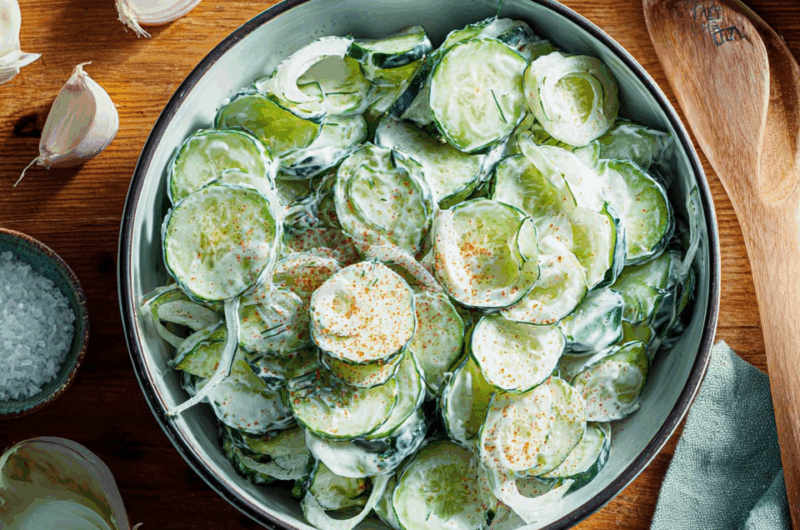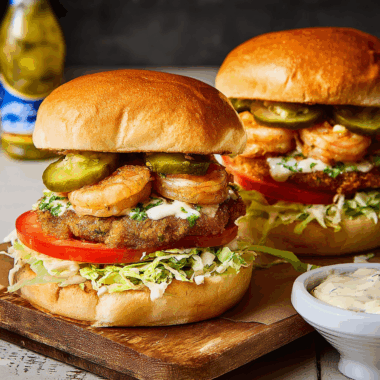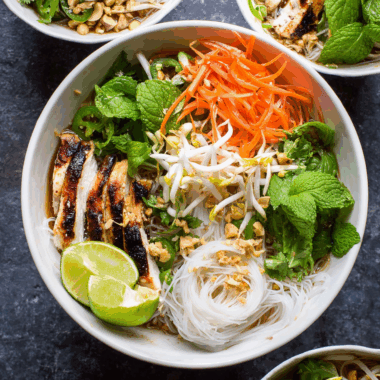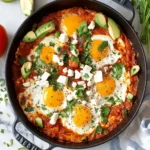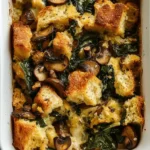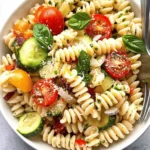The refreshing crunch of cucumbers meets the cool tang of sour cream in this classic German dish. Gurkensalat is the perfect example of how simple ingredients can create layers of flavor—think creamy, herby, sweet, and slightly tangy, all in one bite. A chilled favorite from central Europe, it’s ideal for hot days or hearty meals.
Gurkensalat is not just a salad—it’s a comforting side that speaks of family dinners, garden harvests, and timeless traditions. With dried dill, parsley, and just a hint of paprika, the flavors are well-balanced and nostalgic. Whether you’re serving schnitzel, grilled meats, or a vegetarian spread, this salad delivers cooling satisfaction with elegance.
Full Rercipe:
-
2 large cucumbers, sliced thin
-
½ medium onion, sliced thin (optional)
-
1 teaspoon salt
-
½ cup sour cream
-
2 tablespoons white sugar
-
2 tablespoons white vinegar
-
1 teaspoon dried dill
-
1 teaspoon dried parsley
-
¼ teaspoon paprika, or to taste
Directions:
-
Place cucumber and onion slices on a large platter. Sprinkle salt over them and let sit for 30 minutes.
-
Drain the cucumber and onion mixture in a colander. Squeeze gently to remove excess moisture and pat dry with paper towels.
-
In a large bowl, mix sour cream, sugar, vinegar, dill, and parsley until well combined.
-
Fold in the cucumber and onion slices, coating evenly with the dressing.
-
Cover the bowl and refrigerate for at least 3 hours, preferably overnight for deeper flavor.
-
Garnish with a dusting of paprika just before serving.
Prep Time: 20 minutes | Marinating Time: 3 hours 30 minutes | Total Time: 3 hours 50 minutes
Kcal: 108 kcal | Servings: 4 servings
A Taste of Germany: The Charm of Gurkensalat
Gurkensalat, or German cucumber salad, is a beloved staple of traditional German cuisine. Known for its crisp texture, creamy consistency, and subtle balance of sweet, tangy, and herby flavors, this salad is far more than a humble side dish—it’s a reflection of cultural heritage, seasonal eating, and the German knack for transforming simple ingredients into deeply satisfying meals.
Whether served alongside schnitzel, bratwurst, or as part of a cold buffet during the warmer months, Gurkensalat has earned its place as a timeless classic in German households. This creamy cucumber salad not only delivers on flavor but also showcases the beauty of food simplicity.
Cultural Origins and Historical Context
Gurkensalat has deep roots in German food culture, where fresh produce from gardens or local markets is often turned into simple yet flavorful accompaniments. This dish is traditionally made with cucumbers, sour cream, vinegar, and herbs—ingredients that were widely available even during times of food scarcity in the early to mid-20th century.
The salad was often served in rural households, particularly in Southern Germany and Austria, where sour cream and fresh dill were pantry staples. In the north of Germany, variations with oil and vinegar were more common, while in other regions, people would swap sour cream for yogurt or add mustard for extra zest. It is a dish that reflects regional preferences, seasonal abundance, and family tradition.
Gurkensalat also found its way into immigrant kitchens across the world, particularly in the United States, where German communities introduced it to potlucks and picnics. Its light, refreshing nature and affordability helped it endure as a favorite for generations.
What Makes Gurkensalat Unique?
Unlike many Western cucumber salads that use mayonnaise-heavy dressings, Gurkensalat distinguishes itself with a light and tangy base made from sour cream and white vinegar. This creates a refreshing contrast to heavier dishes, making it ideal for pairing with hearty mains such as schnitzel, roasted meats, or fried potatoes.
The key to this salad’s distinct character lies in its texture and balance of flavors. Thinly sliced cucumbers are often salted first to draw out excess water. This step not only keeps the salad from becoming soggy but also enhances the cucumbers’ natural crunch and allows them to absorb the dressing more effectively.
Herbs like dill and parsley infuse the dish with aromatic freshness, while a touch of sugar and paprika rounds out the flavor profile. The final product is creamy without being rich, tangy but not sour, and always delightfully crisp and cool.
Seasonality and Ingredient Simplicity
One of the beauties of Gurkensalat is its ability to reflect the seasons. During summer, when cucumbers are at their peak, the salad becomes a go-to dish in many German homes. Garden cucumbers, often unpeeled for added texture, are celebrated for their cooling qualities—a perfect antidote to hot weather.
Sour cream adds creaminess without overpowering the salad’s freshness. White vinegar brings acidity and helps preserve the crispness of the cucumbers. Meanwhile, dill—a staple herb in German kitchens—contributes a delicate grassy note that plays beautifully with the sweet-tangy dressing.
These ingredients are inexpensive and readily available, which means you don’t need to spend much to serve something truly delicious. Gurkensalat proves that food doesn’t need to be complex or extravagant to be exceptional.
Modern Variations and Creative Twists
While the traditional version of Gurkensalat is beloved, it has inspired countless variations. Some cooks prefer to use Greek yogurt instead of sour cream for a healthier, tangier twist. Others swap out white vinegar for apple cider vinegar, lending a more fruity acidity to the dish.
In more modern or international adaptations, chefs have experimented with additions such as minced garlic, chives, mustard, or even a sprinkle of crumbled feta cheese. Some home cooks choose to include radishes, shredded carrots, or thin slices of red onion to give the salad more visual appeal and a peppery bite.
For vegan diets, dairy-based sour cream can be substituted with plant-based alternatives made from cashews or coconut cream, preserving the salad’s signature creaminess while accommodating dietary needs.
Despite these modern takes, most versions retain the essential elements of the original—cool cucumbers, a creamy-tangy dressing, and fragrant herbs.
Pairing Suggestions and Serving Ideas
Gurkensalat is versatile enough to pair with a variety of dishes. In traditional German meals, it’s often served alongside pan-fried pork schnitzel or bratwurst. Its acidity and freshness help cut through the richness of meats, balancing the meal beautifully.
It’s also an excellent side dish for grilled proteins like chicken or fish, offering a cooling contrast during barbecue season. Alternatively, it can be served as part of a larger buffet spread or a light lunch when paired with boiled potatoes and a slice of rustic bread.
For more contemporary meals, Gurkensalat can add freshness to grain bowls, sandwiches, or even avocado toast. You can also serve it chilled in small bowls as an appetizer or as a refreshing palate cleanser between courses.
No matter the setting, this salad is always a welcome presence—refreshing, flavorful, and full of character.
Nutritional Benefits
Gurkensalat is not only delicious but also relatively healthy. Cucumbers are low in calories and high in water content, making them hydrating and ideal for digestion. They also contain small amounts of vitamin K, vitamin C, and potassium.
The dressing, while creamy, can be adjusted to suit dietary needs. By reducing the amount of sugar or opting for yogurt instead of sour cream, the recipe can become a light, protein-rich addition to any meal.
For those following vegetarian diets, this salad is a wonderful way to incorporate more vegetables and herbs into the day without relying on heavy fats or overly processed ingredients.
Why Gurkensalat Stands the Test of Time
What makes Gurkensalat enduringly popular is its balance of simplicity, nostalgia, and adaptability. It embodies the essence of homemade comfort food—rooted in tradition, yet flexible enough to evolve with modern tastes and ingredients.
Unlike trendy dishes that fade with time, Gurkensalat has stayed relevant across generations, cultures, and continents. Its comforting flavor and ease of preparation make it accessible to new cooks, while its depth and heritage appeal to those who appreciate food as a form of cultural storytelling.
The beauty of this dish lies in its understatement. It’s not flashy or fussy—it simply delivers what it promises: a fresh, flavorful, and satisfying salad that honors its roots and elevates the everyday meal.
Conclusion: Celebrating Simplicity with Every Bite
In the world of fast-paced culinary innovations and complex flavor combinations, Gurkensalat is a refreshing reminder that some of the best dishes come from keeping things simple. With just a few humble ingredients, this creamy German cucumber salad manages to deliver cooling comfort, versatility, and timeless flavor.
Whether you’re revisiting childhood memories, exploring German cuisine for the first time, or looking for a dependable side dish to complement your main course, Gurkensalat is a recipe worth returning to again and again. Its heritage speaks of tradition; its flavor speaks for itself.
So next time you’re standing in your kitchen with a couple of fresh cucumbers and a tub of sour cream, think of Gurkensalat. Simple. Satisfying. And unmistakably German.

